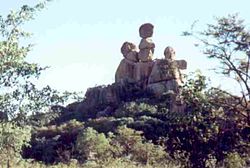Balancing rocks | |
|---|---|
Topographic feature | |
 Balancing formation seen in Matobo National Park, known as the Mother and Child inselberg | |
 | |
| Location | Zimbabwe |
Balancing rocks are found in many parts of Zimbabwe. These geomorphological features are formed of igneous rocks. Particularly noteworthy balancing rocks are located in Matobo National Park and near the township of Epworth, to the southeast of Harare.
